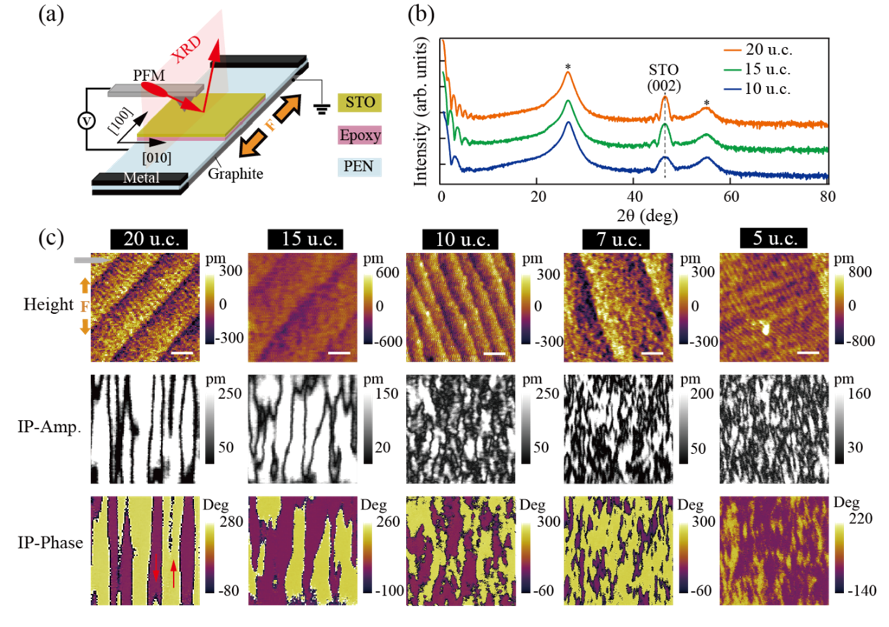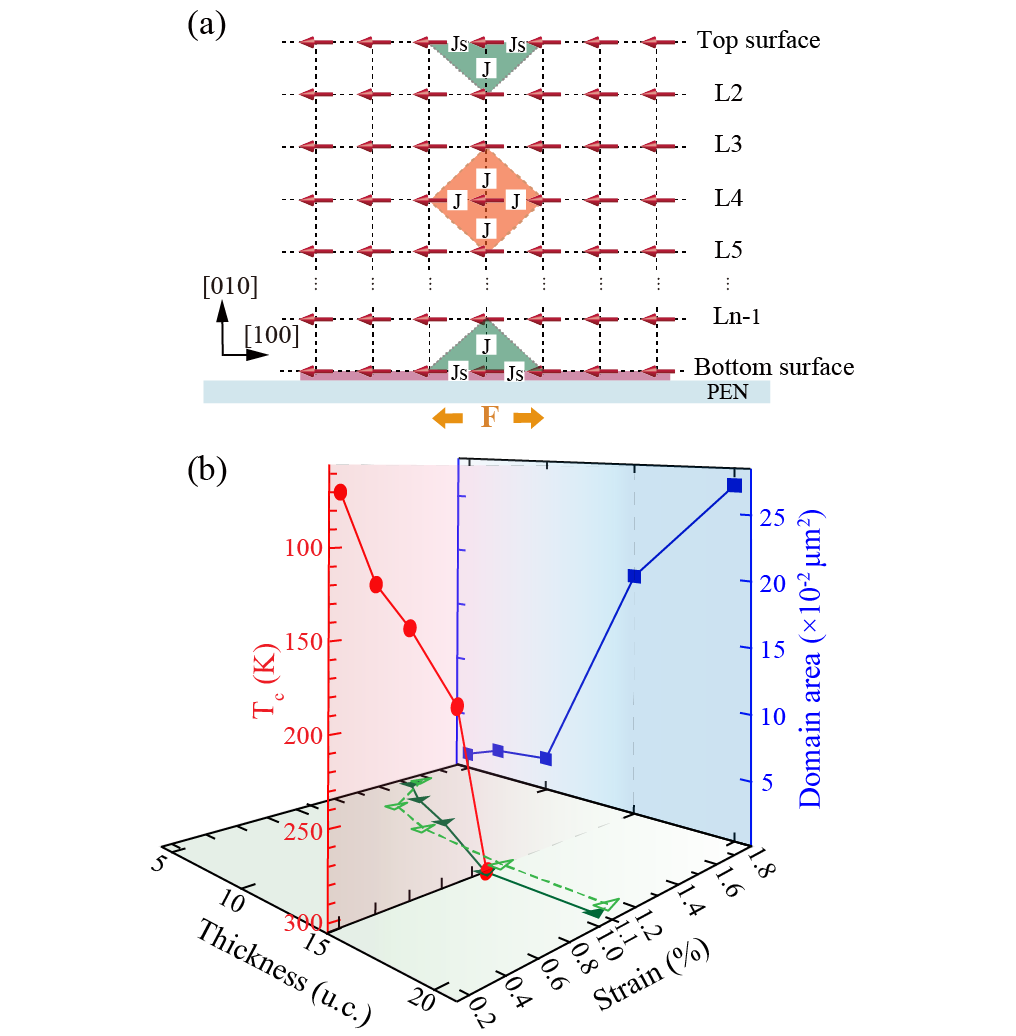Recently, a collaborative research team lead by Prof. Yuefeng Nie and Prof. Di Wu from the college of Engineering and Applied Sciences of Nanjing University reported a new study of the dependence of ferroelectric stability on film thickness in freestanding SrTiO3 films with pure in-plane polarizations. Their results reveal that ferroelectric size effects still exist in the absence of a depolarization field, indicating the important role of dipole-dipole interaction in ferroelectric phase transitions and providing new insights into ferroelectric size effects.
The rapid development of information technologies such as big data, cloud computing, and the Internet of Things has put forward higher requirements for information storage capacity, read/write rates, and power consumption. Ferroelectric perovskite oxides have become an important candidate material system for developing a new generation of high-performance storage devices due to their sub nanosecond ferroelectric polarization reversal speed and ultra-low power consumption. However, studies have found that most perovskite oxide ferroelectric thin films suffer from pronounced size effects, that is, the ferroelectricity will be suppressed or even ruined when the film thickness shrinks down to the nanoscale, limiting their potential applications in high-density memory devices. The reason for such size effects is usually attributed to the ferroelectric instability caused by the increasing depolarization field along the along the normal direction of the film surface as the film thickness decreases. However, there are still many debates about this explanation. Disclosing the key mechanism of size effects in ferroelectrics is of great significance in both basic research and practical device applications.
In this work, we proposed to eliminate the influence of an out-of-plane depolarization field by preparing a material system with pure in-plane polarizations. As such, one can systematically study the key factors determining ferroelectric stability and reveal the underlying mechanism of ferroelectric size effects. However, it is of great challenge to prepare such perovskite ferroelectric oxide films with pure in-plane polarizations for in-situ experiments.In recent years, the emerging freestanding oxide films have manifested excellent tunability, providing new opportunities for related researches. Based on advanced oxide molecular beam epitaxy technology, the research team have prepared a series of ultrathin (several nanometers) freestanding SrTiO3 films (a kind of quantum paraelectric materials) with different thicknesses, and systematically investigated their thickness-dependent stability of ferroelectricity under uniaxial tensile strain. By increasing the in-plane uniaxial tensile strain, pure in-plane polarized room-temperature ferroelectricity can be obtained in ultrathin SrTiO3 membranes, providing a clean and unique system for studying ferroelectric size effects without a depolarization field. It has been found that STO membranes at reduced thickness exhibit suppressed Tc, enhanced critical strain for room-temperature ferroelectricity, andreduced domain size (Figure 1). All these results suggest the presence of a pronounced ferroelectric size effect even without a depolarization field (Figure 2).
Further analysis shows that the number of neighboring dipoles on the surface of the thin film is significantly smaller than in the bulk of the film, and the overall surface dipole-dipole interaction is naturally weaker than in the bulk. Therefore, as the thickness approaching the ultrathin limit, the surface-to-volume ratio is elevated, and weak surface dipole-dipole interactions plays a dominated role. Based on the transverse Ising model, a theoretical simulation of the dependence of ferroelectric instability on film thickness is consistent with experimental observations, providing a reasonable mechanism explanation for the prominent ferroelectric size effect that still exists even without a depolarization field (Figure 2). It is worth mentioning that experimental results show that even in the thinnest films (5 u.c.), room-temperature ferroelectricity exists, which indicates that the critical thickness may be absent in these systems as long as the dipole-dipole interaction is strong enough. Therefore, this study inspires new insights into ferroelectric size effects and provides instructive design for ferroelectric devices.

Figure 1| a) Schematic of the device for strain engineering and in situ measurements. b) High-resolution XRD 2θ-ω scans for 10-20 u.c. thick STO/epoxy/PEN samples. c) LPFM characterizations revealing thickness-dependent domain structures under a fixed strain of 1.8%.

Figure 2|a) Schematic illustration of the dipole-dipole interaction. b) Summarized phase diagram of STO membranes unveiling how ferroelectricity (domain area and Tc) evolves with film thickness and uniaxial strain. Solid lines represent the experimental results and the green dashed line is the simulated data obtained from the transverse Ising model.
The relevant work has been published in the journal of Physical Review Letters entitled " Prominent size effects without a depolarization field observed in ultrathin ferroelectric oxide membranes" (DOI: 10.1103/PhysRevLett.130.126801). Dr. Haoying Sun is the first author, and Prof. Yuefeng Nie and Prof. Di Wu are the co-corresponding authors of the paper. Both Jiahui Gu and Dr. Yongqiang Li are important collaborators in this research. Prof. Evgeny Y. Tsymbal (University of Nebraska at Lincoln), and Prof. Tula R. Paul(South Dakota School of Mines and Technology), Prof. Junming Liu (the School of Physics of Nanjing University), and Prof. Houbing Huang (Beijing Institute of Technology) have provided important theoretical support for this work.This work has also been supported by projects such as the National Key R&D Program of China, the National Natural Science Foundation of China, and the “Chang Jiang Scholars Program” of the Ministry of Education. In addition, the National Laboratory of Solid State Microstructures of Nanjing University, the Collaborative Innovation Center of Advanced Microstructures and Jiangsu Key Laboratory of Artificial Functional Materials also provided important support for this research.

